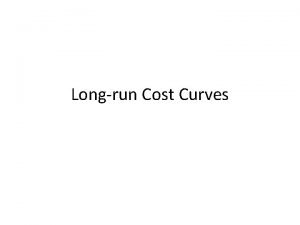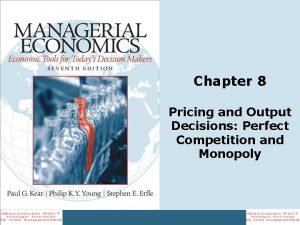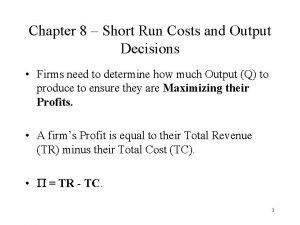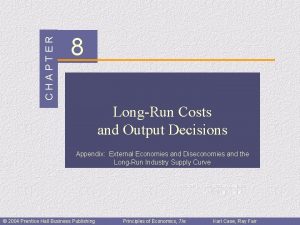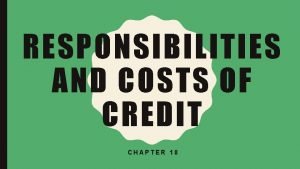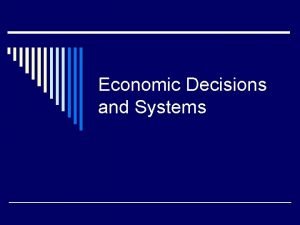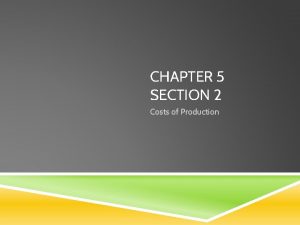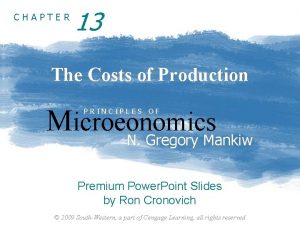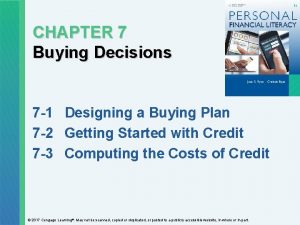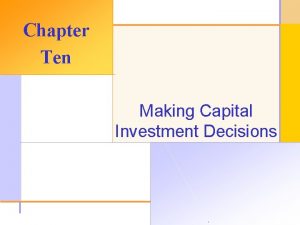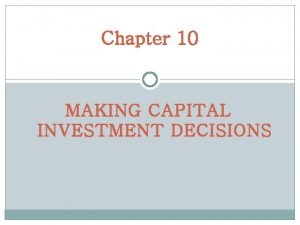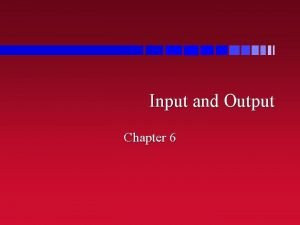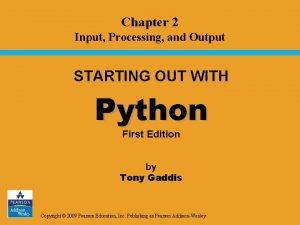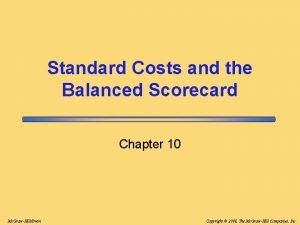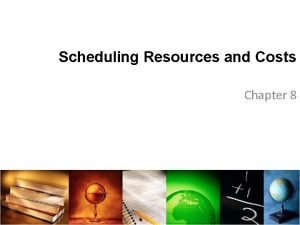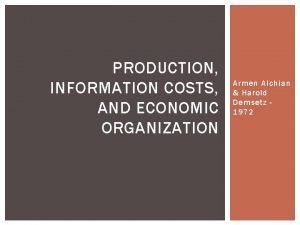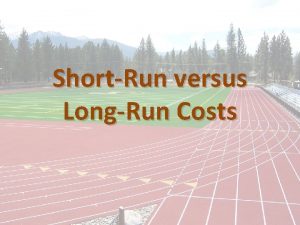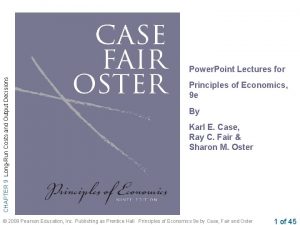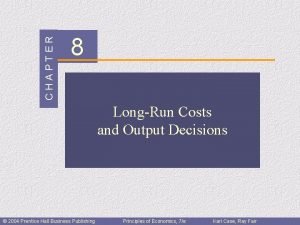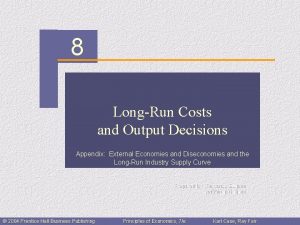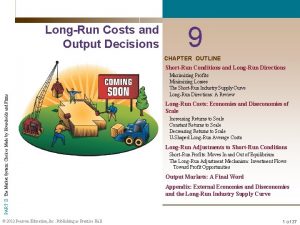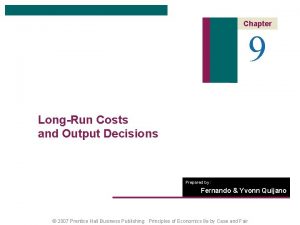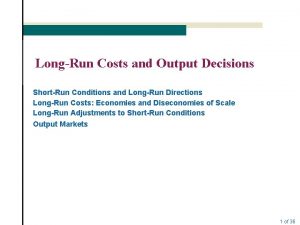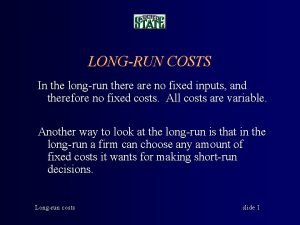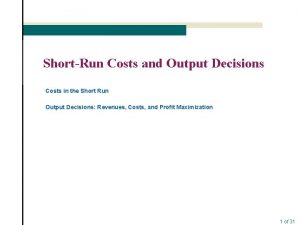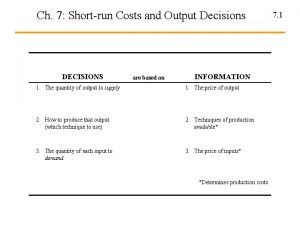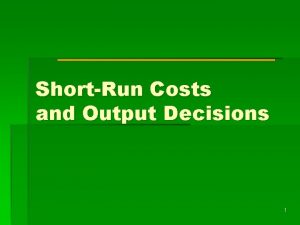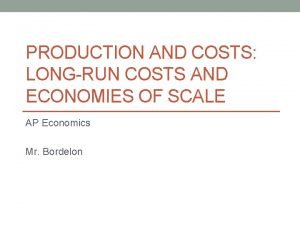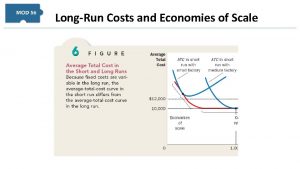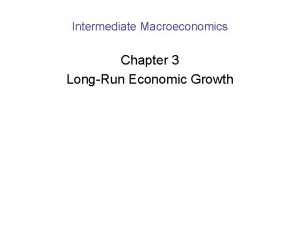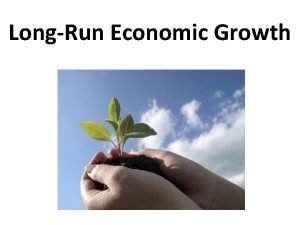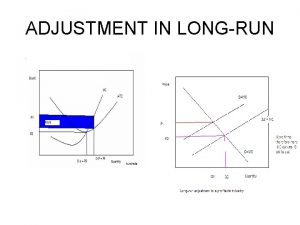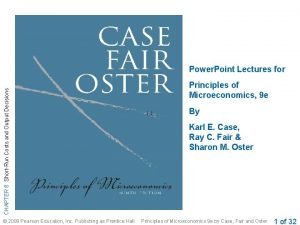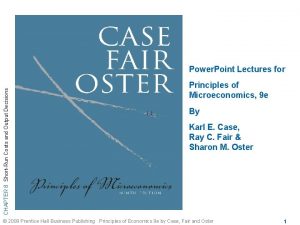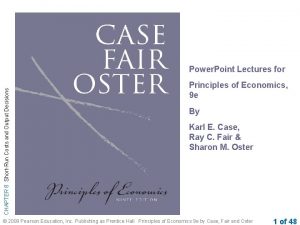LongRun Costs and Output Decisions Chapter 9 1


























- Slides: 26

Long-Run Costs and Output Decisions Chapter 9 1

LONG-RUN COSTS AND OUTPUT DECISIONS l We begin our discussion of the long run by looking at firms in three short-run circumstances: l l l firms earning economic profits, firms suffering economic losses but continuing to operate to reduce or minimize those losses, and firms that decide to shut down and bear losses just equal to fixed costs. 2

3

4

SHORT-RUN CONDITIONS AND LONG-RUN DIRECTIONS MINIMIZING LOSSES l operating profit (or loss) or net operating revenue Total revenue minus total variable cost (TR - TVC). l l If revenues exceed variable costs, operating profit is positive and can be used to offset fixed costs and reduce losses, and it will pay the firm to keep operating. If revenues are smaller than variable costs, the firm suffers operating losses that push total losses above fixed costs. In this case, the firm can minimize its losses by shutting down. 5

6

7

SHORT-RUN CONDITIONS AND LONG-RUN DIRECTIONS l Remember that average total cost is equal to average fixed cost plus average variable cost. This means that at every level of output, average fixed cost is the difference between average total and average variable cost: ATC = AFC + AVC or AFC = ATC - AVC = $4. 10 - $3. 10 = $1. 00 l As long as price (which is equal to average revenue per unit) is sufficient to cover average variable costs, the firm stands to gain by operating instead of shutting down. 8

9

SHORT-RUN CONDITIONS AND LONG-RUN DIRECTIONS l l Any time that price (average revenue) is below the minimum point on the average variable cost curve, total revenue will be less than total variable cost, and operating profit will be negative —that is, there will be a loss on operation. In other words, when price is below all points on the average variable cost curve, the firm will suffer operating losses at any possible output level the firm could choose. When this is the case, the firm will stop producing and bear losses equal to fixed costs. This is why the bottom of the average variable cost curve is called the shut-down point. l At all prices above it, the marginal cost curve shows the profitmaximizing level of output. l At all prices below it, optimal short-run output is zero. 10

SHORT-RUN CONDITIONS AND LONG-RUN DIRECTIONS l shut-down point The lowest point on the average variable cost curve. When price falls below the minimum point on AVC, total revenue is insufficient to cover variable costs and the firm will shut down and bear losses equal to fixed costs. l The short-run supply curve of a competitive firm is that portion of its marginal cost curve that lies above its average variable cost curve 11

12

13

SHORT-RUN CONDITIONS AND LONG-RUN DIRECTIONS: A REVIEW 14

LONG-RUN COSTS: ECONOMIES AND DISECONOMIES OF SCALE l increasing returns to scale, or economies of scale An increase in a firm’s scale of production leads to lower costs per unit produced. l constant returns to scale An increase in a firm’s scale of production has no effect on costs per unit produced. l decreasing returns to scale, or diseconomies of scale An increase in a firm’s scale of production leads to higher costs per unit produced. 15

LONG-RUN COSTS: ECONOMIES AND DISECONOMIES OF SCALE INCREASING RETURNS TO SCALE The Sources of Economies of Scale l Most of the economies of scale that immediately come to mind are technological in nature. l Some economies of scale result not from technology but from sheer size. 16

LONG-RUN COSTS: ECONOMIES AND DISECONOMIES OF SCALE Graphic Presentation l long-run average cost curve (LRAC) A graph that shows the different scales on which a firm can choose to operate in the long run. 17

LONG-RUN COSTS: ECONOMIES AND DISECONOMIES OF SCALE 18

LONG-RUN COSTS: ECONOMIES AND DISECONOMIES OF SCALE CONSTANT RETURNS TO SCALE l Technically, the term constant returns means that the quantitative relationship between input and output stays constant, or the same, when output is increased. l Constant returns to scale mean that the firm’s longrun average cost curve remains flat. 19

LONG-RUN COSTS: ECONOMIES AND DISECONOMIES OF SCALE 20

LONG-RUN COSTS: ECONOMIES AND DISECONOMIES OF SCALE l l All short-run average cost curves are U-shaped, because we assume a fixed scale of plant that constrains production and drives marginal cost upward as a result of diminishing returns. In the long run, we make no such assumption; instead, we assume that scale of plant can be changed. It is important to note that economic efficiency requires taking advantage of economies of scale (if they exist) and avoiding diseconomies of scale. optimal scale of plant The scale of plant that minimizes average cost. 21

LONG-RUN ADJUSTMENTS TO SHORT-RUN CONDITIONS 22

LONG-RUN ADJUSTMENTS TO SHORT-RUN CONDITIONS l l l l Firms will continue to expand as long as there are economies of scale to be realized, and new firms will continue to enter as long as positive profits are being earned. In the long run, equilibrium price (P*) is equal to long-run average cost, short-run marginal cost, and short-run average cost. Profits are driven to zero: P* = SRMC = SRAC = LRAC where SRMC denotes short-run marginal cost, SRAC denotes shortrun average cost, and LRAC denotes long-run average cost. No other price is an equilibrium price. Any price above P* means that there are profits to be made in the industry, and new firms will continue to enter. Any price below P* means that firms are suffering losses, and firms will exit the industry. Only at P* will profits be just equal to zero, and only at P* will the industry be in equilibrium. 23

LONG-RUN ADJUSTMENTS TO SHORT-RUN CONDITIONS 24

LONG-RUN ADJUSTMENTS TO SHORT-RUN CONDITIONS l l l As long as losses are being sustained in an industry, firms will shut down and leave the industry, thus reducing supply—shifting the supply curve to the left. As this happens, price rises. This gradual price rise reduces losses for firms remaining in the industry until those losses are ultimately eliminated. Whether we begin with an industry in which firms are earning profits or suffering losses, the final long-run competitive equilibrium condition is the same: P* = SRMC = SRAC = LRAC and profits are zero. At this point, individual firms are operating at the most efficient scale of plant—that is, at the minimum point on their LRAC curve. 25

LONG-RUN ADJUSTMENTS TO SHORT-RUN CONDITIONS l long-run competitive equilibrium When P = SRMC = SRAC = LRAC and profits are zero. 26
 Good decision making poster
Good decision making poster Lratc curve
Lratc curve Screening decisions and preference decisions
Screening decisions and preference decisions Pricing and output decisions in perfect competition
Pricing and output decisions in perfect competition Short run cost and output decisions
Short run cost and output decisions Long run cost and output decisions
Long run cost and output decisions Chapter 18 responsibilities and costs of credit
Chapter 18 responsibilities and costs of credit Chapter 4 financial decisions and planning
Chapter 4 financial decisions and planning Chapter 4 financial decisions and planning
Chapter 4 financial decisions and planning Chapter 10 personal loans and purchasing decisions
Chapter 10 personal loans and purchasing decisions Chapter 1 economic decisions and systems answer key
Chapter 1 economic decisions and systems answer key Chapter 4 financial decisions and planning
Chapter 4 financial decisions and planning Chapter 4 financial decisions and planning
Chapter 4 financial decisions and planning Chapter 4 financial decisions and planning
Chapter 4 financial decisions and planning Chapter 5 section 2 costs of production
Chapter 5 section 2 costs of production Active learning 3 calculating costs
Active learning 3 calculating costs Designing a buying plan
Designing a buying plan An organized method for making good buying decisions.
An organized method for making good buying decisions. Tax shield formula
Tax shield formula Nwc change
Nwc change Chapter 6 input and output
Chapter 6 input and output Chip and pin reader input or output
Chip and pin reader input or output Chapter 2 input processing and output
Chapter 2 input processing and output Voev-inc
Voev-inc What are the impacts of resource constrained scheduling
What are the impacts of resource constrained scheduling Trade off and opportunity cost
Trade off and opportunity cost Production, information costs, and economic organization
Production, information costs, and economic organization

